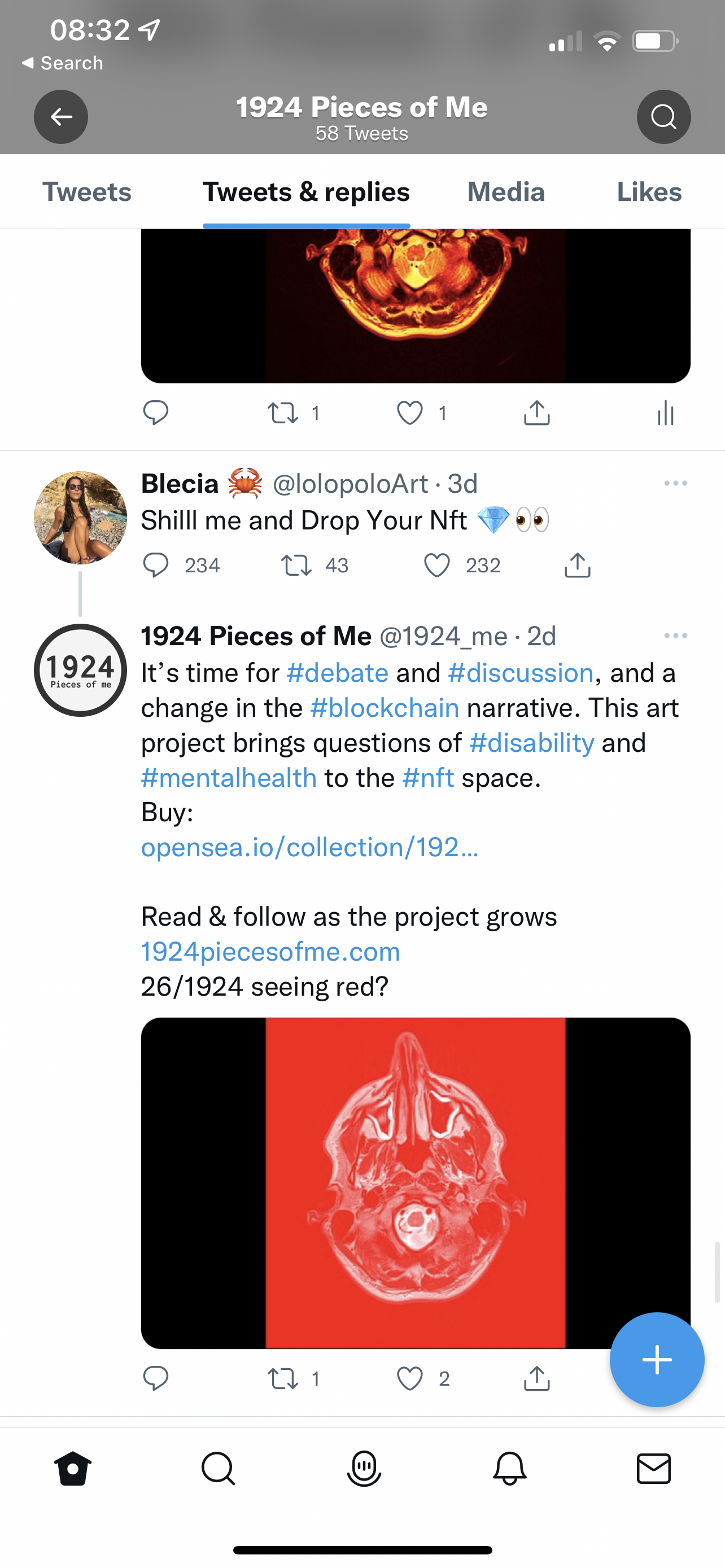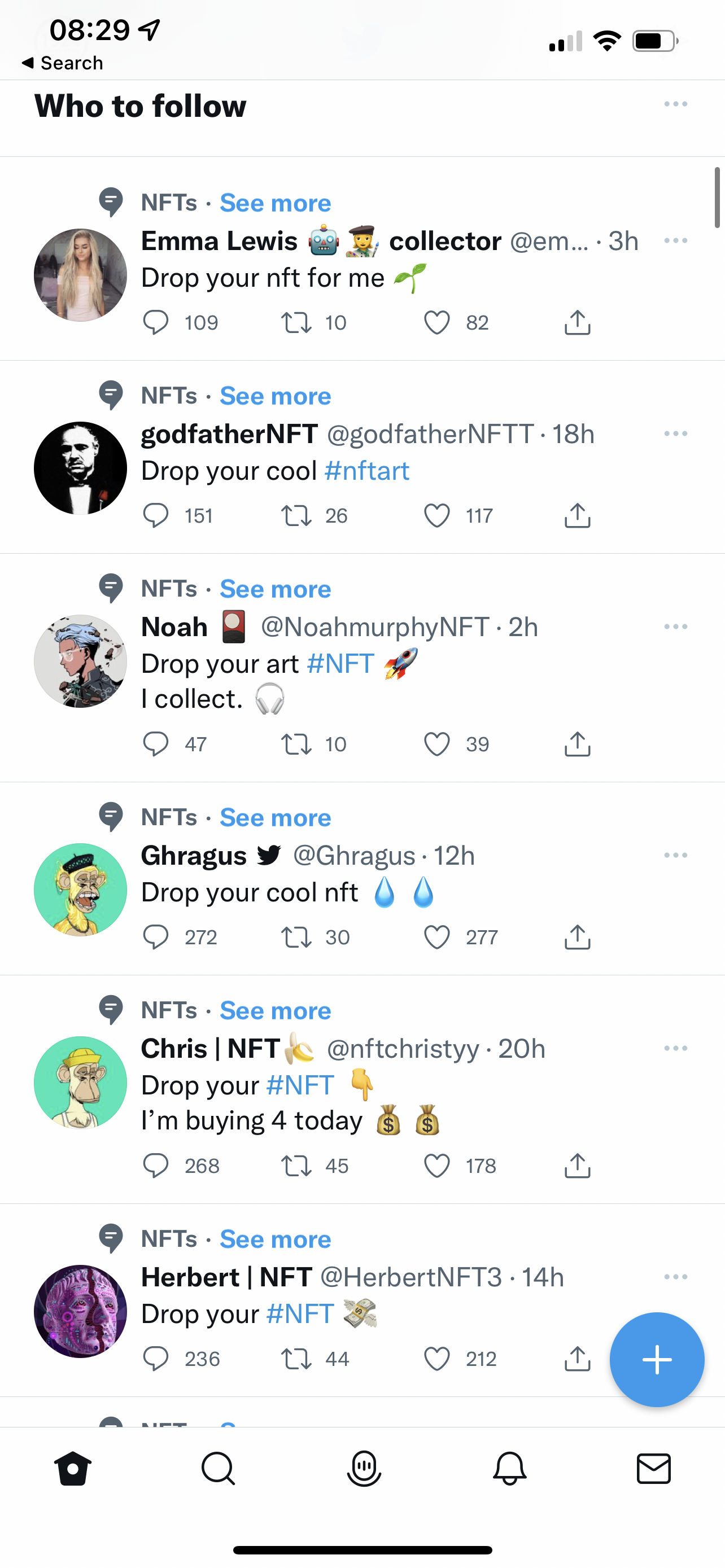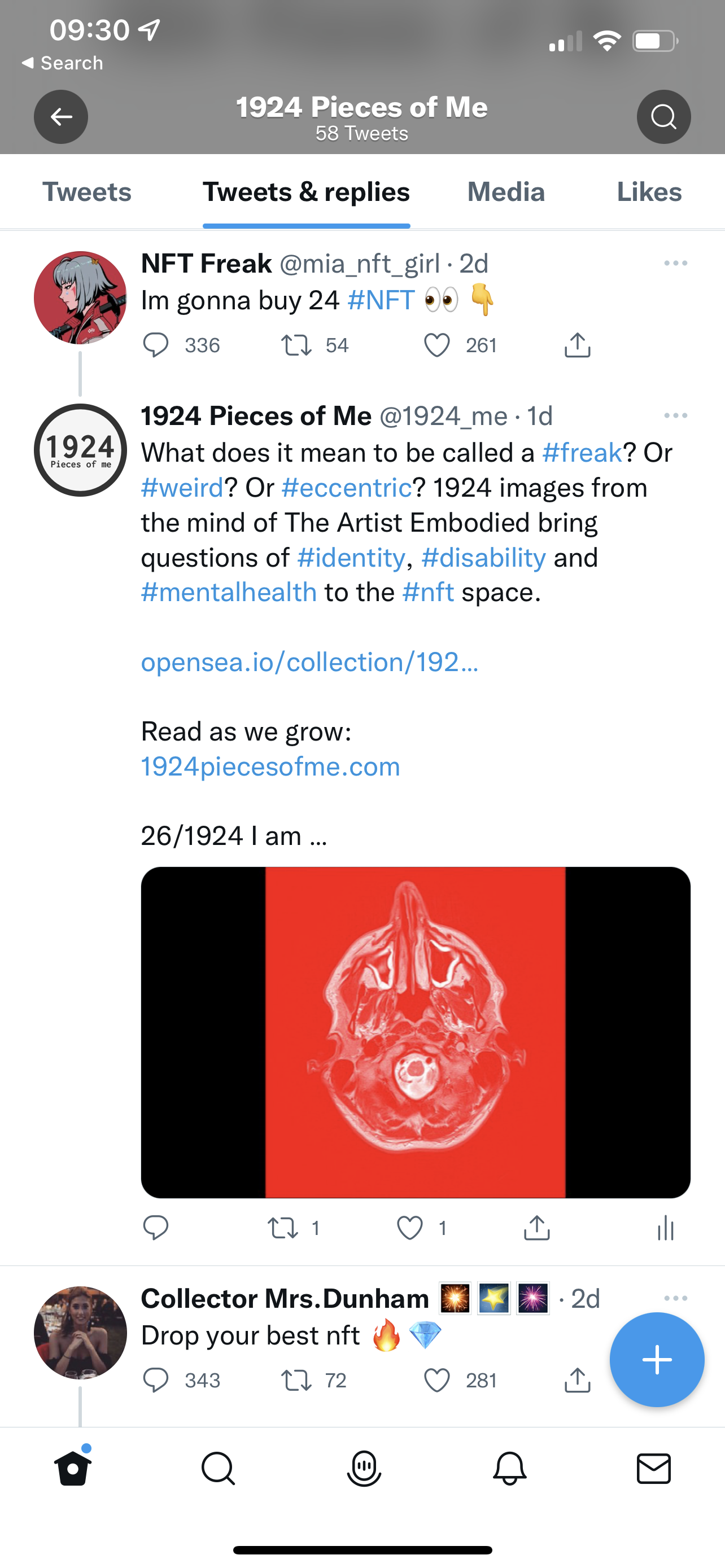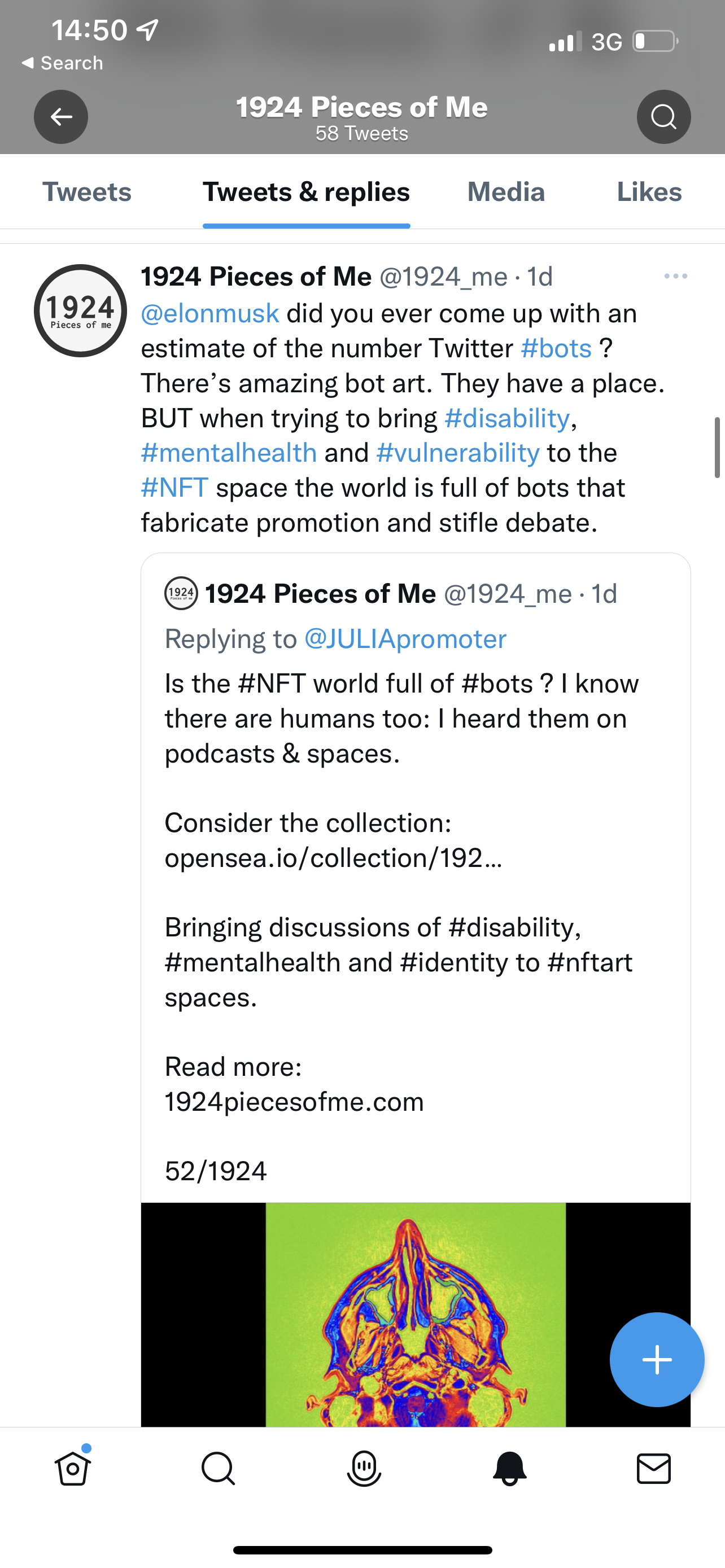As of a couple of days ago fifty percent of Me is live (for sale) on Opensea. That is to say that pieces 1/1924 to 962/1924 have been “minted” and listed for sale. They should appear in order but, to be honest, I am only human so there are a few errors in the number order. The human touch is important throughout this project in terms of content, practice, praxis and process.
I considered programming my own “smart contract” to manage the the process, but this carried an upfront cost in “gas fees” which I could not afford. Also, it seemed important to do the labour of creation and implementation myself. This may seem an unusual choice when working in the Web 3.0-enabled space of non-fungible token (NFT) art where a huge number of “successful” projects are iterative in nature and/or constructed by algorithms. Indeed, given that the process pushes certain of my neurodiversity and disability buttons, I was possibly more prone to mistakes and definitely more likely to be slower than the average bear (to paraphrase Yogi Bear for no particular reason). “You know you could download a free bot to do that?” piped up my son (19), as I sat cursing quietly to myself after making a mistake that required hours of unpicking. I haven’t googled to see if he is correct, although I am reasonably sure I could subcontract it out to another human, if not to a bot or some other form of automatation.
The majority of “marketing” for NFTs seems to take place in the Web 2.0 space (i.e. what’s now considered to be traditional social media) with, as far as I can tell, Twitter being the platform of choice for creators and collectors to interact.
“Who’s going to want to buy pictures of your brain anyway?” says my son (13). That’s not a bad question. I wonder who will? I suppose I am hoping that if I can create interest in the philosophical issues I am trying to raise, then “collectors” will buy in to that narrative. However, I wonder if the space is ready for questions and debates about identity, ownership, disability, mental health and vulnerability? I remember, not for the first time, that I was warned by those operating outside the NFT and blockchain space that they felt like it would not be a safe place for this kind of project. I continue to hope that I can disprove that.
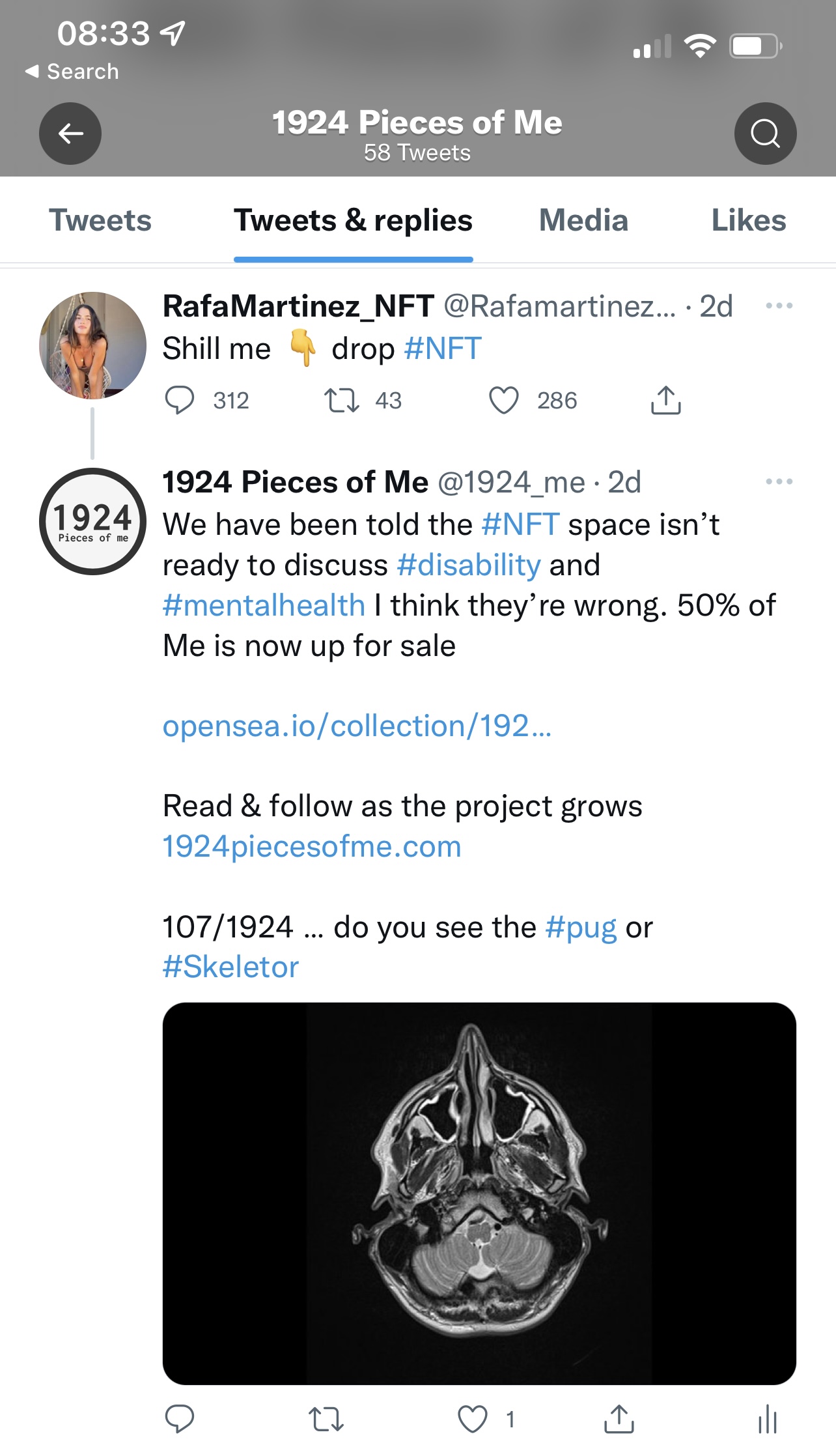
I have spent the weekend actively engaging with the Twitter-based world of NFT collectors and creators (so much so that I have had to resist the urge to insert a series of hashtags here and there as I write). It is a strange place full of bots and automated messages (which seems hardly suprising given the nature of the beast). I have been “shilling” and “dropping” my artwork as best I can; the calls for it are endless. But no one has bitten yet. Perhaps my artwork is not aesthetically pleasing or my price too high. Who knows, it remains early days for the project.
My son (19), apparently the fount of all knowledge, tells me that I should have “created hype” before releasing the images for sale. However, it seemed to me that the images needed to be in exististence before I could have the discussions I wanted to have, and indeed now they do “exist” as NFTs they have taken on a strange tangible quality that is some how different to the original images from which they are created. That feels somewhat ridiculous to say as they are intangible and ephemeral by their very nature. However, they seem to be somehow more concrete once listed for sale than they are were when I curated and aranged them into the silent video, for example. Each image is fixed, perhaps by the signing of the token at the point of listing (the confirmation of the minting in the blockchain). That being said, the creation of the video brings the images to life for me; a friend tells me “the artwork is meditative, silence worked perfectly”. Of course, the images themselves fix a moment of my life in time. From live subject to fixed image to digital immortality in the blockchain: a snapshot of a life.
And so my mind returns to the language of the space I have recently come to inhabit. My Twitter feed is full of repeated calls to “shill” or “drop” NFTs for sale. The implication being that semi-immediate purchase or promotion will follow… and there follows hundreds of posts of images from creators hungry for a sale. Aren’t we all? I feel uneasy responding to the calls to “shill” as the word seems disingenous as a term of art. I feel that it has a sense of dishonesty within its regular meaning. A quick reference to the dictionary confirms my thinking. As a noun, the word (according to the Oxford Languages Dictionary that powers Google Definitions means): “an accomplice of a confidence trickster or swindler who poses as a genuine customer to entice or encourage others” and the corresponding verb means to “act or work as a shill”. I cannot help but wonder how the adoption of a phrase that implies dishonesty has affected the development of attitudes within the space. Is it simply assumed that no one is what or who they seem? Where does that leave a project which is intrinsically tied to my identity and personhood, albeit under the sobriquet of The Artist Embodied?
My response is to share details of the project on these posts with commentary about the issues we hope to raise, and a selected Piece of Me for consideration. I wonder if I would have more success if I just posted the image without commentary, but it feels important to be as authentic as possible. The discussion is part of the art and part of the point, isn’t it?
The other word that is used a lot in these posts is “drop” which conjours a sense of abandonment: “let your art fall here and walk away”. It conjurs a fleeting, ephemeral quality. Dispose of it like litter: here in my feed. The language is important, and I wonder how much it is influencing the atmosphere of the space. I recently read about the philosophical artlang Toki Pona. Consisting, at the time of its inception, of only 120 words, the creator (linguist Sonja Lang) hoped the new language would encourage people to think through things and would encourage more positive statements. This would then have a more positive impact on speakers’ mental health and outlook through positive thinking. This is a function of the Sapir–Whorf hypothesis, otherwise known as linguistic relativity. Simply put, it suggests the structure of a language affects the way speakers think and constuct their worldview. As such, people’s perceptions are relative to their spoken language(s). I jokingly wonder if the hypothesis explains why the Klingons in Star Trek are always so warlike, a function of the harsh construction of their language. I cannot help wondering if the choice of these negative words as the working terms of the NFT space creates negative worldviews, cognitions and perceptions within the community? Does this ultimately create an inhospitable environment? Similar conclusions might be drawn about the adoption of financial trading terminology such as “bull” and “bear” markets which is frequently used within the space.
Each call for shills or drops gets hundreds of replies, and it seems likely that my comments will be lost in the noise. That being said, I have been pleased to see a couple of likes and retweets from outside of the NFT space.
Where possible, I try to respond to clues in the “collector’s” post or twitter handle, and tailor my commentary towards them. This is of course impossible for the majority of accounts that follow a boilerplate “Drop/Shill your NFT here” format, but there are occasions where it is possible. For example, when replying to NFT Freak I was reminded of the many occasions I had faced name calling and other forms of anti-social behaviour in my life. I asked:
What does it mean to be called a #freak? Or #weird? Or #eccentric?
This question has been on my mind a lot because of the time of year. The 11th of August is the anniversary of the murder of Sophie Lancaster. Sophie was killed in what was a de facto hate crime against her (and her partner) because they were “different”. What did Sophie do to attract fatal abuse from her attackers?: Nothing, except follow her passions and be comfortable with herself. Perhaps you might say she was “a goth” The Sophie Lancaster Foundation website explains:
She and her boyfriend were creative, artistic people who dressed in their own unique way. They were attacked by a gang of five boys in a park in Bacup, Lancashire on 11 August 2007. The gang attacked Sophie’s boyfriend first and then turned on her, carrying out a brutal and sustained attack.
I was fortunate to work with Sophie’s mother, Sylvia, at various points over the last fifteen years as she campaigned tirelessly to stop the same thing happening to other people. Sylvia Lancaster sadly passed away earlier this year, and will be is greatly missed. If you ever get the chance to hear Black Roses, the poetic docu-drama by Simon Armitage, take that chance. The language is powerful.
So I continue to engage with the NTF Twitter-verse in as authentic a way as possible. I suppose that this is one of those tasks I could automate or delegate but again it feels important to do it myself and to keep it as responsive as possible. I am hesitant even to cut and paste, trying to make each response unique. Trying to avoid the appearance of being a bot.
When replying to one “collector’s” post, I noticed that he had 797 replies already. What hope would mine have of being seen? As I composed reply number 798 to this thread, I located image 798/1924 (Position 16, Colour Scheme 18) in the hope that the subtle quirk of attempting to match the number of the reply with titular name of the attached image might pique some form of intellectual interest in the audience. When posting I asked:
Do #nftcollectors hear the voices of the #artists in the #NFTCommunity? People tell me this not the #nft space to discuss #vulnerability, #disability and #mentalhealth.

As I gaze at the image of what appears to be a lime green walnut: I see a grimacing face partly obscured so I only see the mouth and nose. Then I notice the face of a rabbit staring back at me, or is it a guinea pig?
“Is that two faces kissing, one upside down?” asks my friend as she looks at the image over my shoulder. I can see it where she points, two slug-like aliens kissing. To me they both appear to be upside down. Maybe she she saw something else? I smile to myself for a moment, happy to know that even slug-like alien figures find love. I glance away and the face of the rabbit/guinea pig comes back into focus. I wonder what that means.
Continuing my experimental (perhaps, in more ways than one: I am the guinea pig I see?) exploration of the NFT space, the other thing I have become heavily aware of is bots. As soon as I started to tweet about NFTs, I immediately experienced bot interactions, some more ovious than others. Some accounts seem to automatically reply to your tweet to suggest you promote your project on one service or another. Some accounts will send you a direct message saying that that they are so grateful for the follow, but have you seen their friend’s amazing site which will promote your project if … The list goes on with any number of variations. There are some obvious phishing scams.
I wonder how many of the innumerable collectors asking creators to shill or drop our NFTs are automated scripts posting and gathering information for whatever reason. I posed this question in another largely ignored reply to a shill request:
Is the #NFT world full of #bots? I know there are humans too: I heard them on podcasts & spaces.
Remembering that Elon Musk had ended his attempt to buy Twitter because of a lack of clarity about the number of bots on the platform, I decided to share that tweet with him too.
I asked him:
@elonmusk did you ever come up with an estimate of the number Twitter #bots ? There’s amazing bot art. They have a place. BUT when trying to bring #disability, #mentalhealth and #vulnerability to the #NFT space the world is full of bots that fabricate promotion and stifle debate.
I don’t know where the line is between useful/legitimate automation and malignancy but it feels like the NFT space (and other parts of the Twitter-verse) might be walking that fine line - or may well have already crossed it? It certainly feels like they are fabricating the possibility of promoting artwork and art work, and crowding the space so much as to stifle genuine interaction.
I doubt he’ll reply, but we can add that to the list of things that I hope to disprove with this project. I suppose it is a little bit eccentric of me to expect the richest man in the world to take an interest in my questions. Perhaps, I can say the rabbit made me do it, or was it the guinea pig, or the kissing slug-like aliens? Either way, he can rest assured that the message came from a human, not a bot.
What do_you_ think? Tell me on Twitter @1924_me
Where does the artist end and the image begin?
The full collection of 1924 Pieces of Me will be available on Opensea to view and collect. Find out more.
You can also explore the collection on YouTube at the 1924 Pieces of Me channel.
